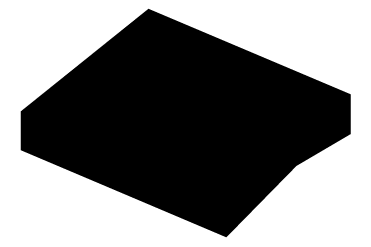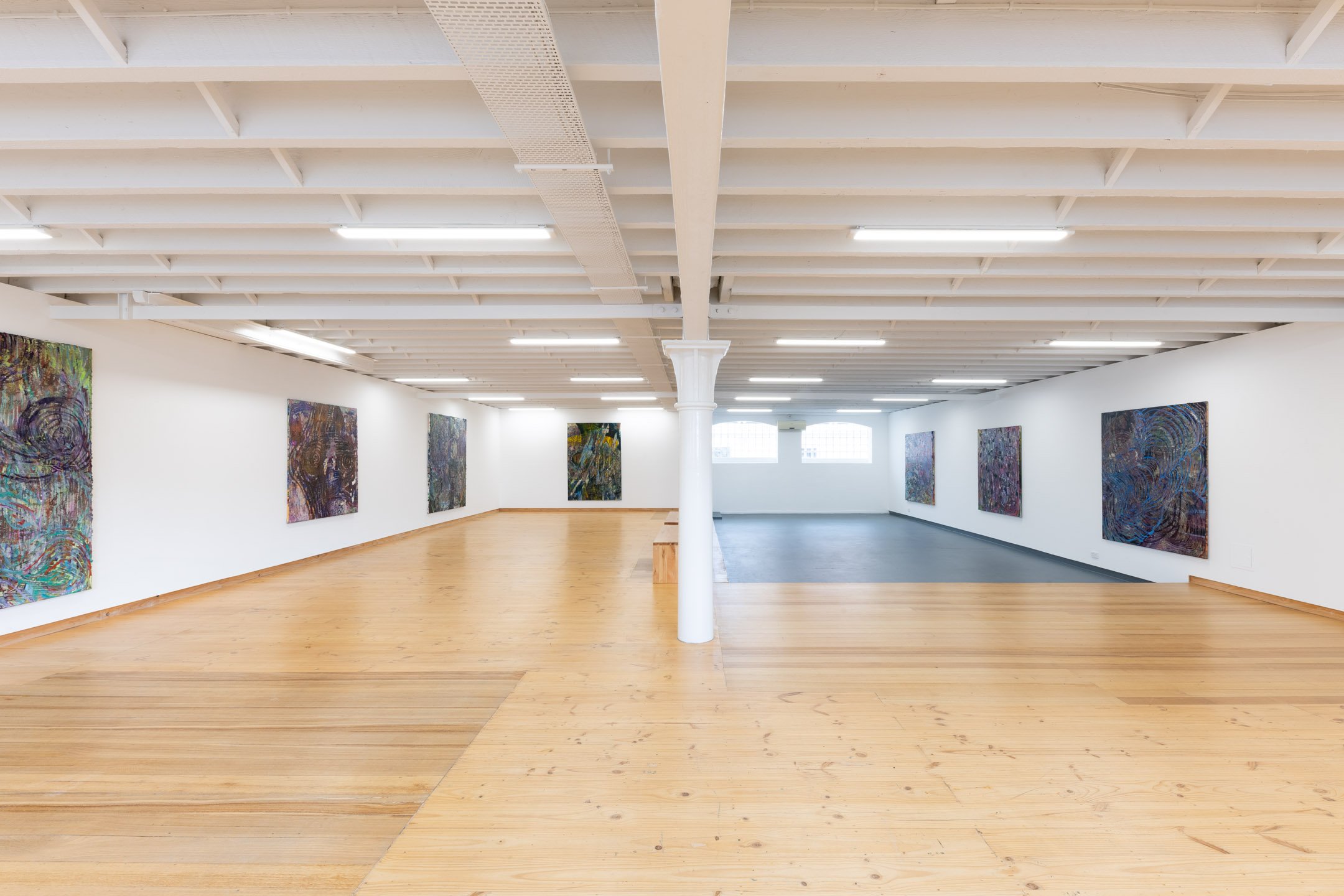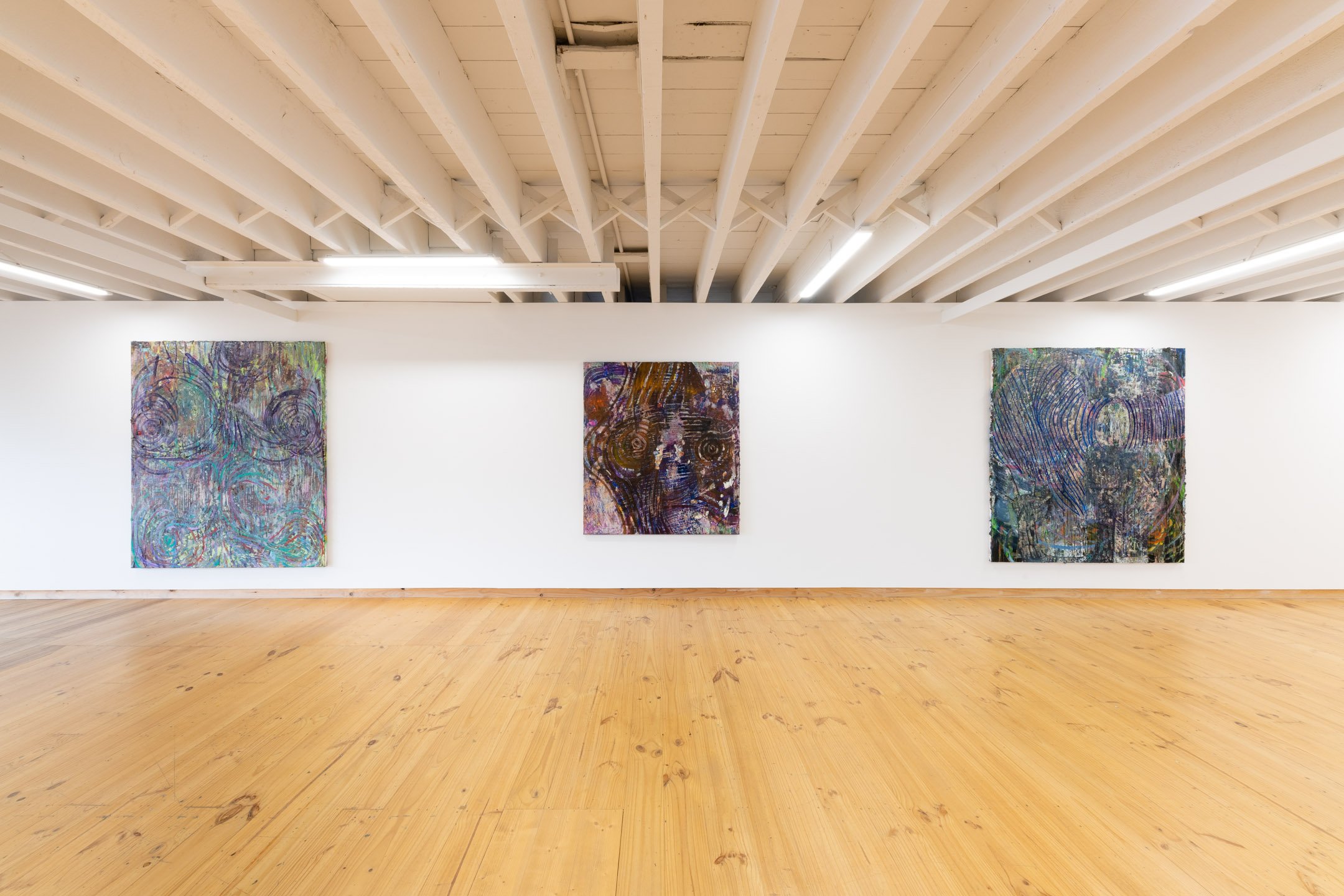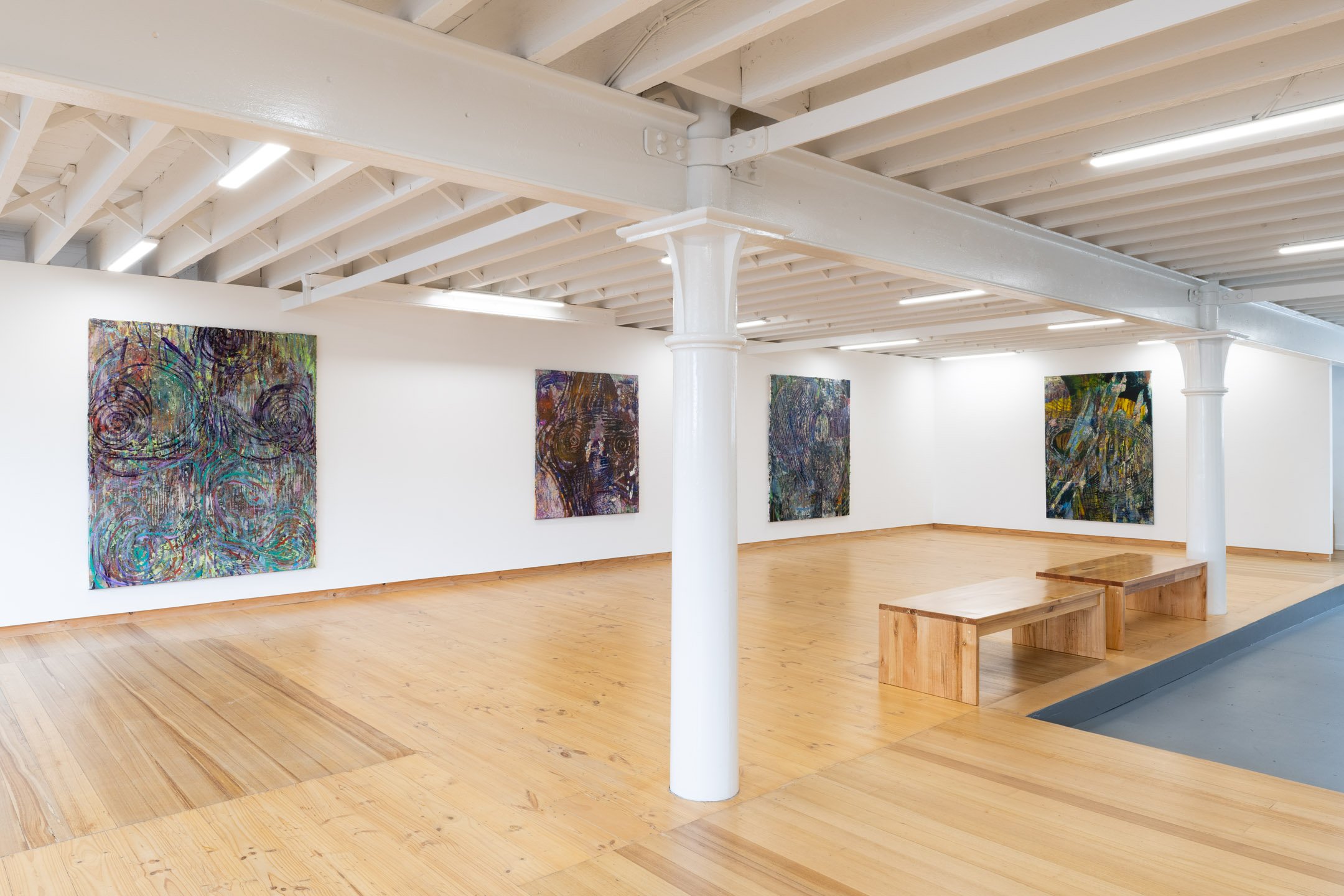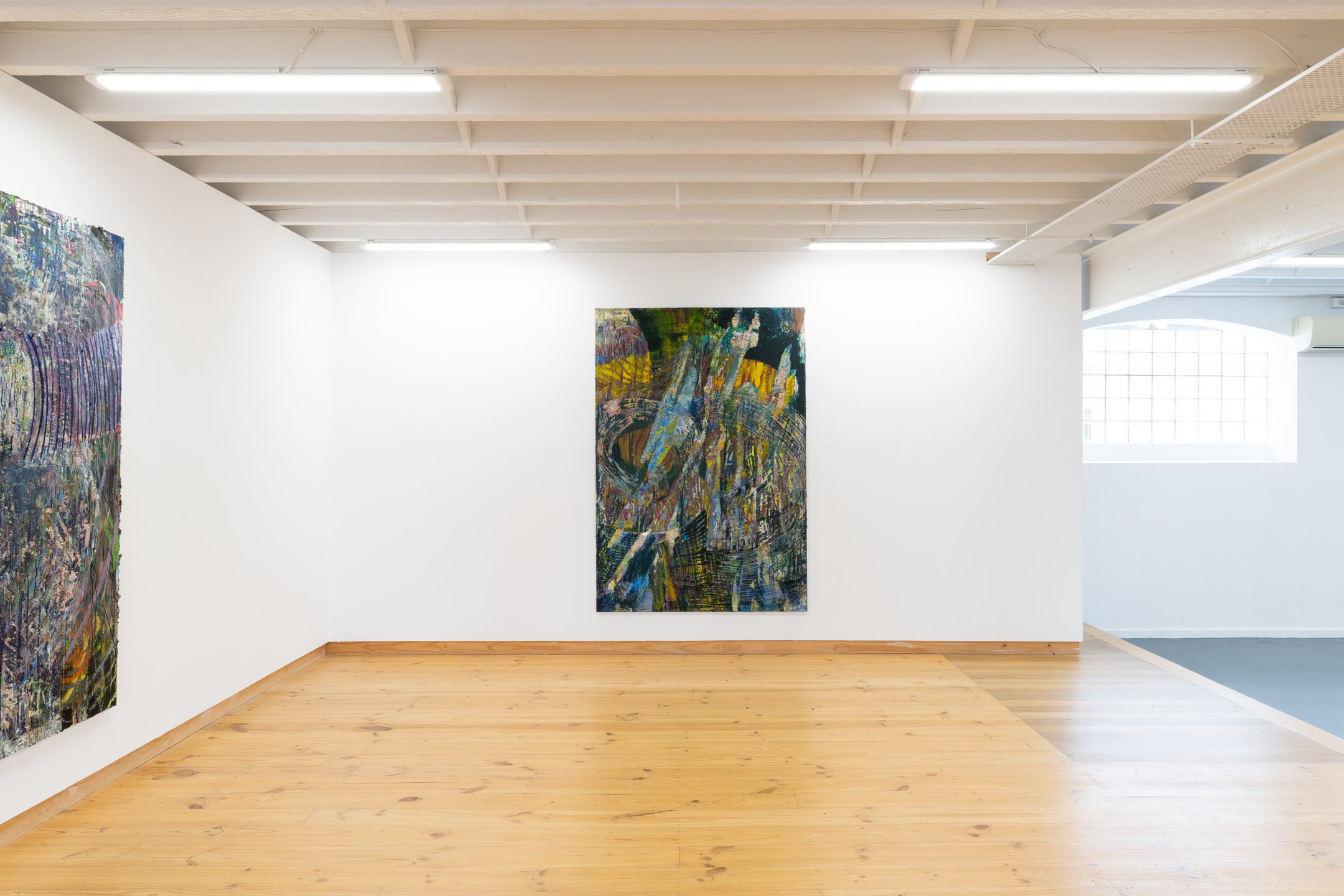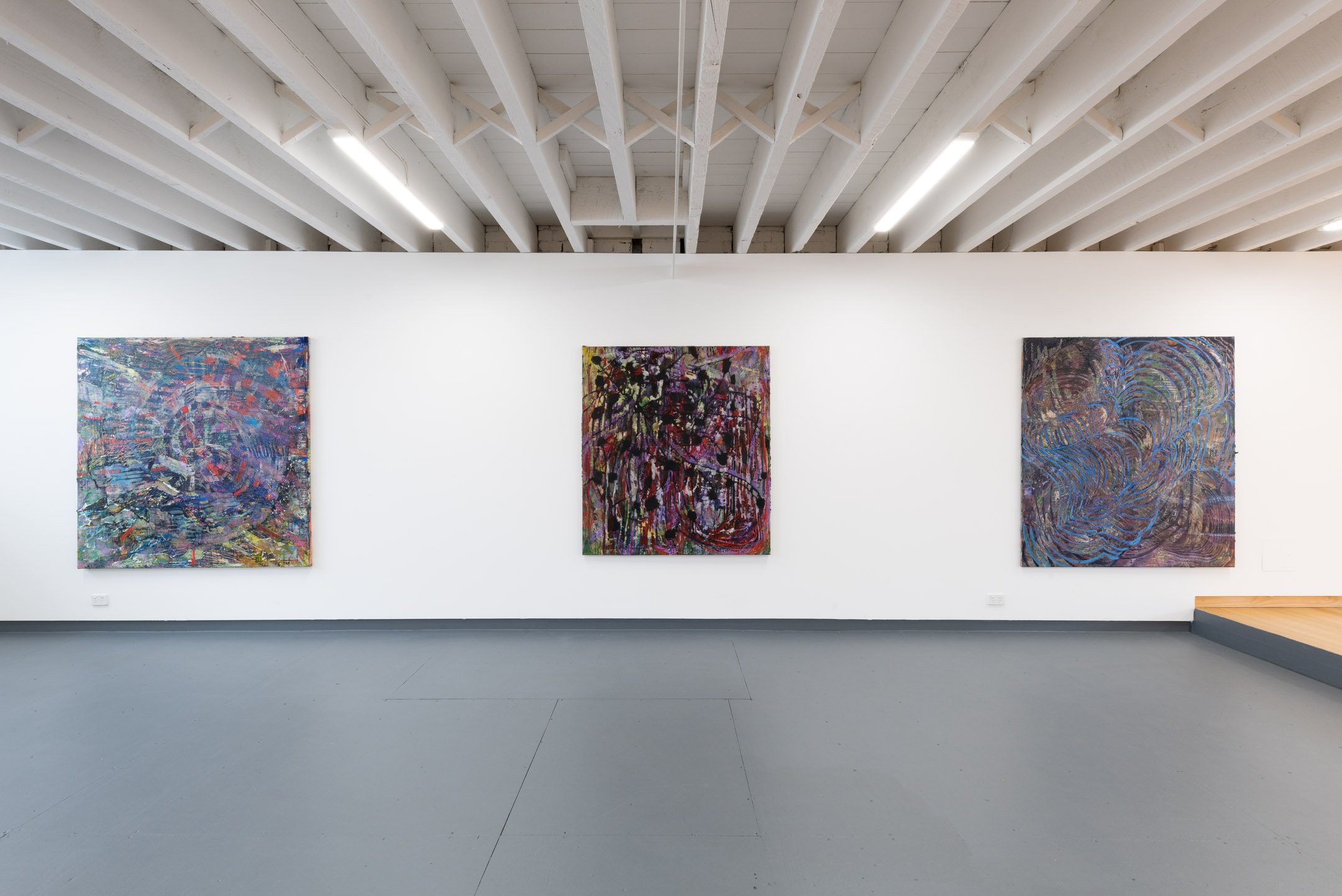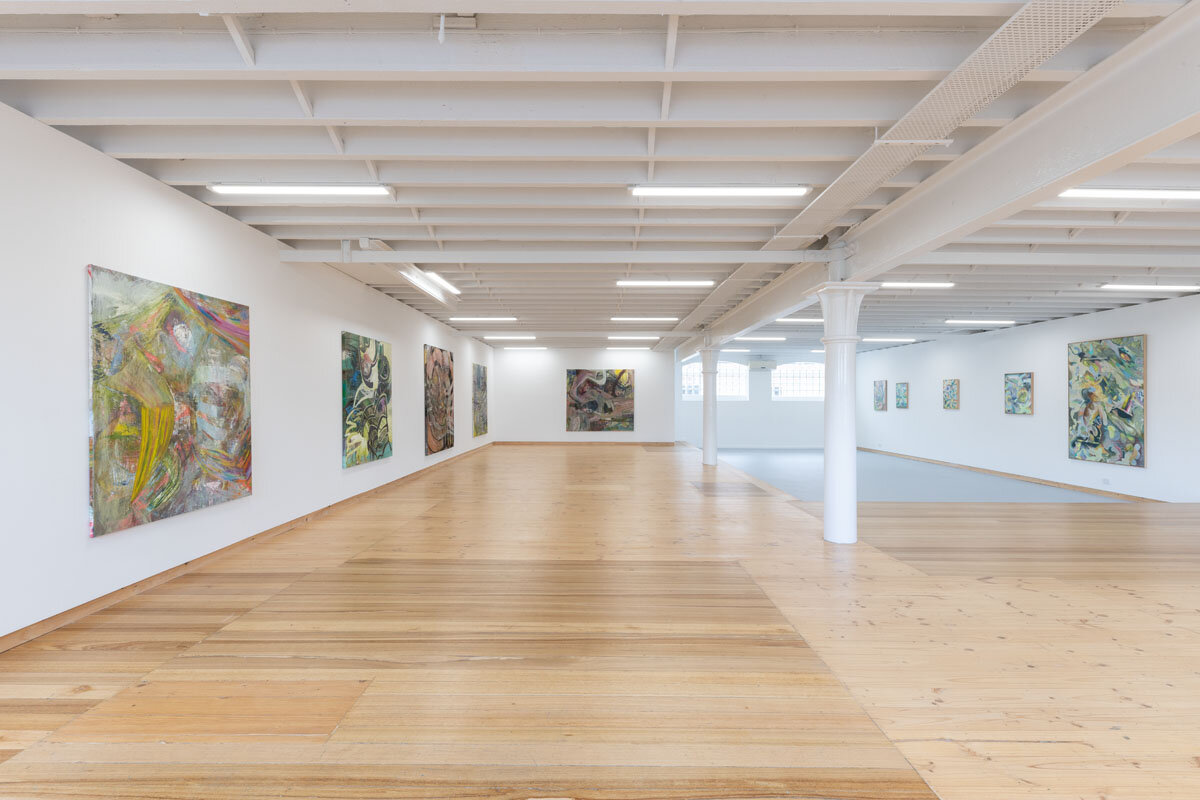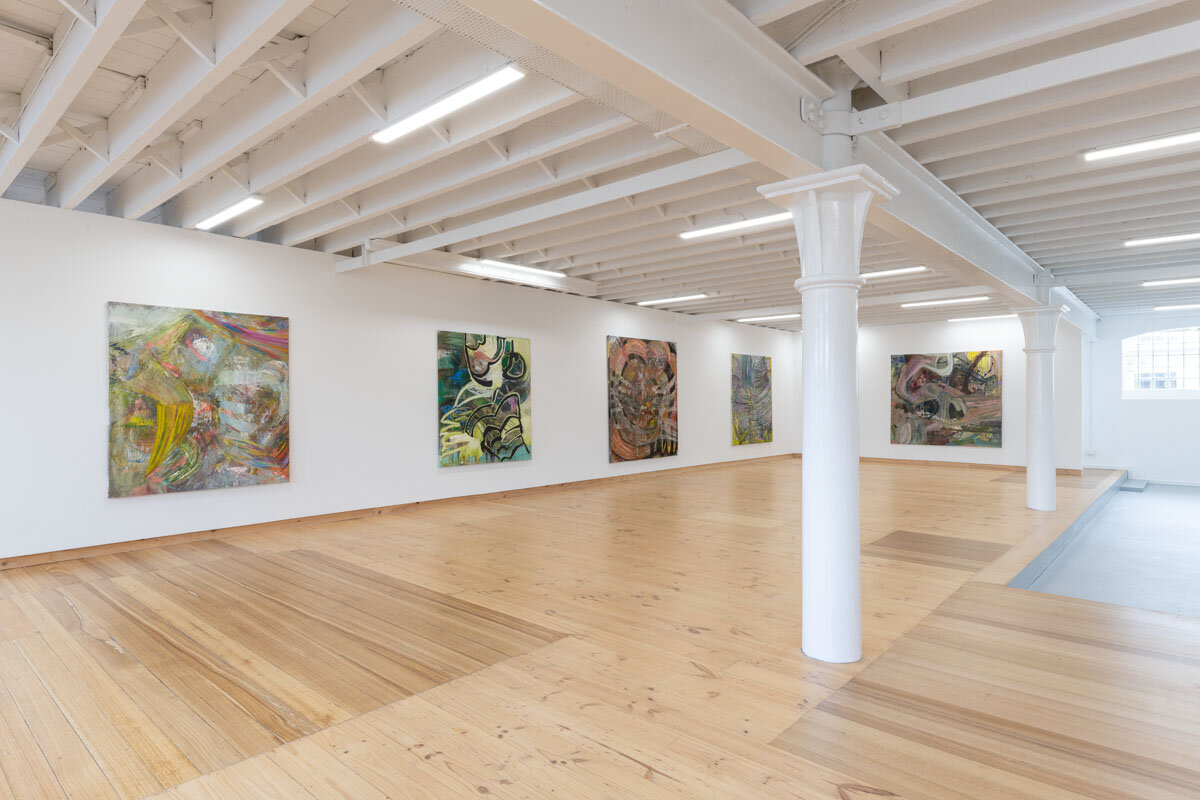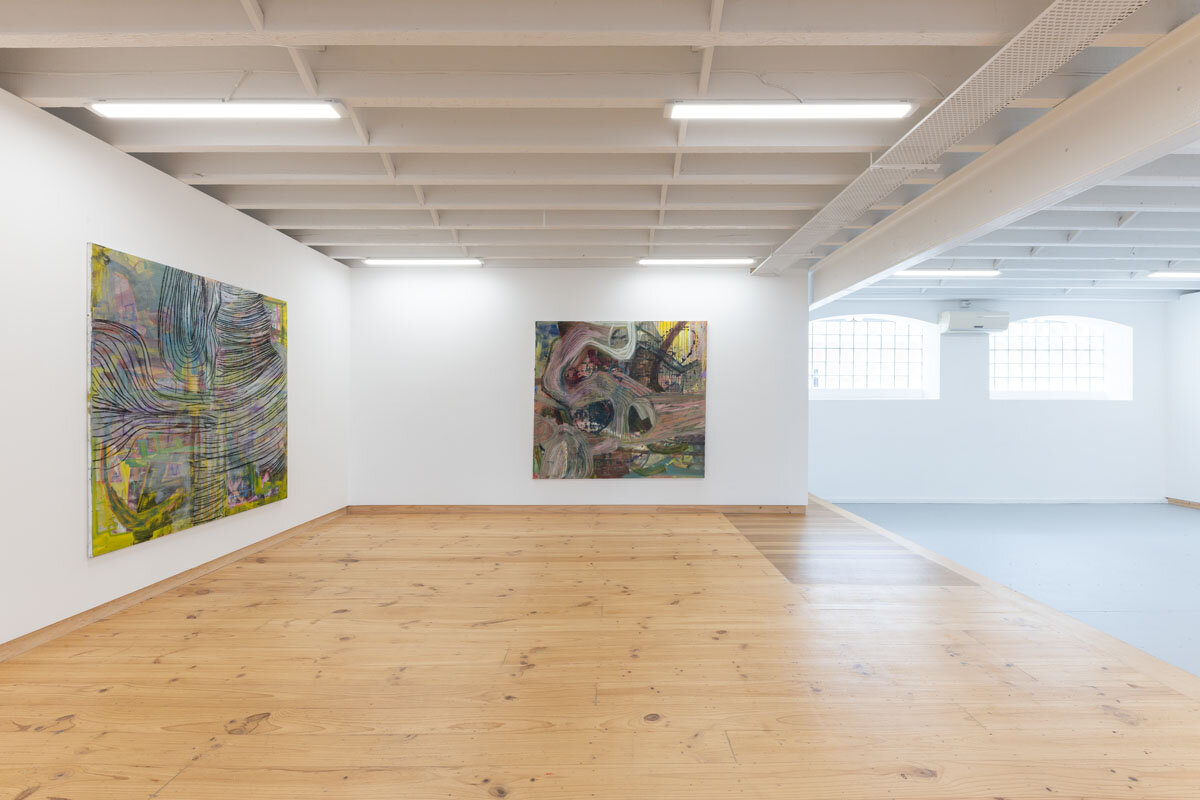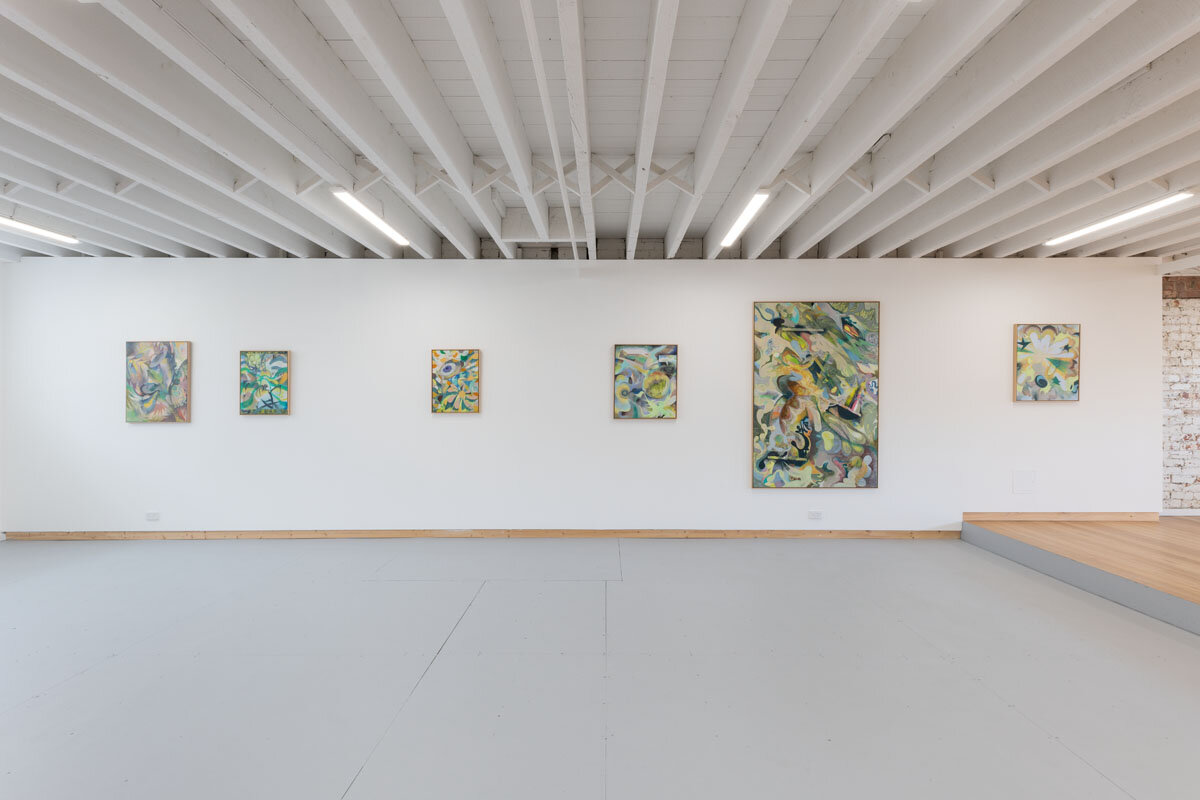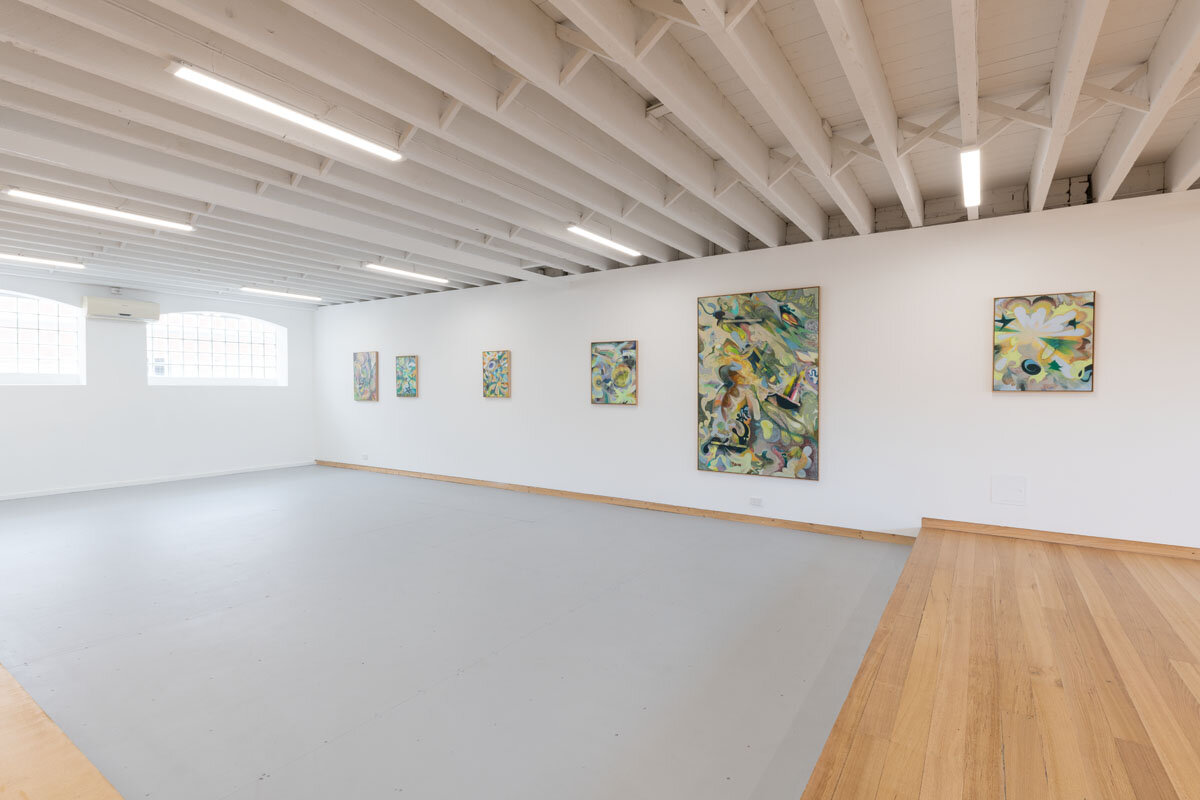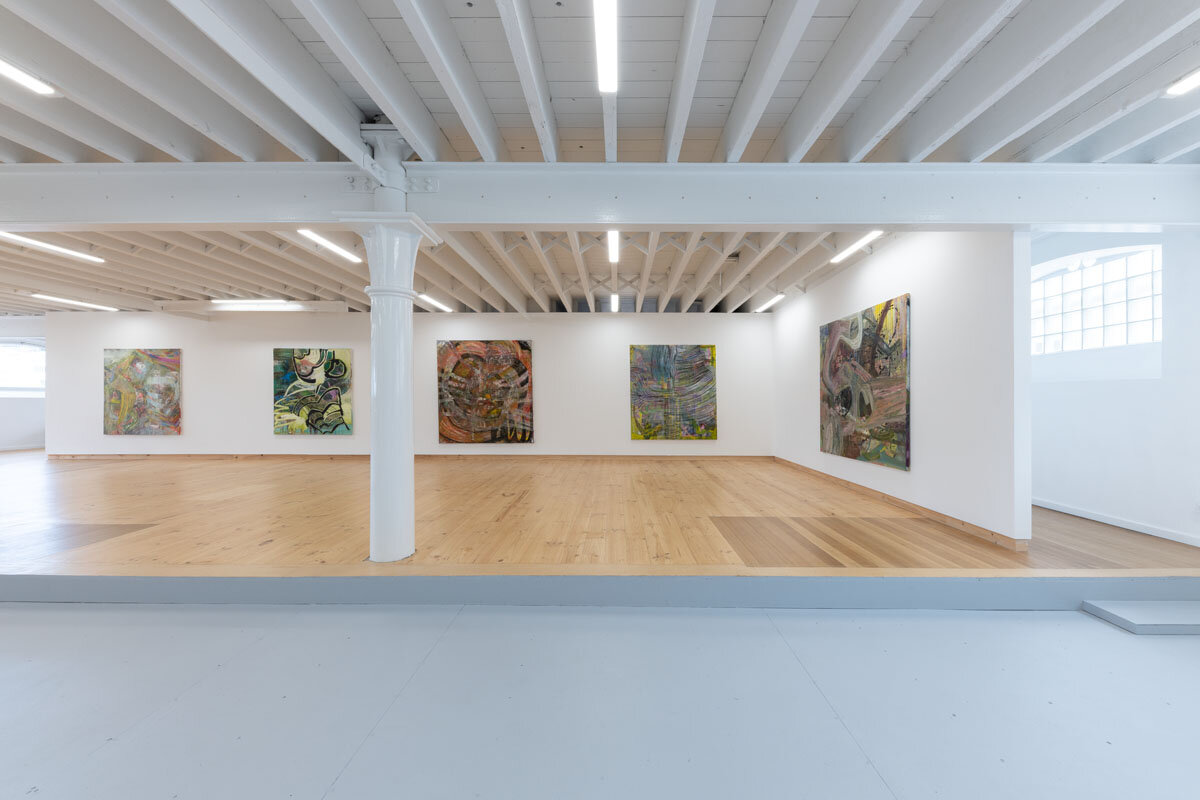georgia biggs: firefighter
Georgia Biggs
13.07.22-06.08.22
Studio images, Georgia Biggs:
Break and enter
In a recent podcast, contemporary artists Keltie Ferris and Peter Halley mull over the challenges and mysteries that present themselves when making paintings. They have known one another for some time – Halley wasFerris’ teacher at the Yale School of Art – and their conversation meanders in tangents, exploring thedecisions that have built their painting practices. Both artists could be seen to be working within contemporary abstraction (although Halley refutes this in the podcast). Ferris makes gestural paintings using spray paint,airbrush and stenciling techniques; Halley creates hard-edged works in a jarring acidic palette that reference prisons and cells. Both artists are united by their interests in the fragment representing the whole, colour, forms of networks and freeing painting from its predecessors, and they flit back and forth from art history as they unpack their lineages.
At one point in the podcast, Abstract Expressionist icon Joan Mitchell comes up. Halley states, on looking at herworks: “They drive me crazy, they’re so tortured!”[1] The expression seems to come with both surprise and reverence,as if he didn’t expect Mitchell’s paintings could do that, and as if they had only recently hit him with their full intensity. Mitchell’s paintings are intense. Made often using sky blues, greens, lilacs and golden yellows on crisp white grounds,they are frequently read as being of nature – a reference encouraged by Mitchell herself when she declared some ofher early pieces “expressionist landscapes.” With nature too often perceived as a controllable and sweet-temperedother in the West – a somewhere and something separate from humans, not an uncontrollable force to which webelong – I wonder if this reference has diluted readings of her work from time to time, making these paintings seem morepassive than they are.
Mitchell’s paintings, for the most part, are ferocious and obsessive, made of many stabbing gestures embroiled infrenetic whirlpools of intensifying colour. They are like birds smashing into each other in flight. Bombs of confetti,blood, guts, garbage, streamers. The sonic fireworks of road rage. If natural, they are heavily weighted cloudsbringing storms; less often, whispery ones swelling for a light shower. The marks in Mitchell’s work come from a placeof deep physicality, drama and gusto. I think about Mitchell when I look at the paintings of Georgia Biggs.
I visited Biggs’ studio when her works for Firefighter were either complete or almost there. Located in Melbourne’s inner west, her studio is a long room without windows, where the institutional hum of fluorescent lights provides an evenand unaffected glow for making paintings. At the end of the space, a dozen huge works huddled like oddarchitectures, their faces to the wall, bars exposed. Paint congealed in piles, like ant mounds sporadically spewing out across the floor, scarring the walls, too.
On her large, raised desk was a stack of small waxy drawings. Their colours were saturated blues and magentas – ajarring yet paradoxically analogous combination, replete with scratches that revealed other colours and marksunderneath. The wax drawings show something of a singular set of actions that are built again and again into Biggs’large paintings in different ways. Also, the magenta reminded me of what German artist Albert Oehlen once said about his “psychopathic” tree paintings from around 2015:“Magenta is a hysterical colour somehow.”[2]
Despite my unease around using the word hysterical in relation to artwork made by a woman, I kept thinking about Biggs and her energy in connection to Oehlen’s. On the internet, there is a video[3] that was uploaded during the height of the pandemic of Oehlen’s studio process, set to music created by German artist Tim Berresheim – a rollercoaster of noise, high-pitched glitches and low drones. In the video, Oehlen mixes paint until it gets muddier and more contaminated with random rubbish, other colours, crusty and thickening old medium. Oehlen then trails the paint mixture across the surface of an almost-there painting he created at some earlier stage. The effect is mesmerising and wonderful, but also quite hysterical, neurotic, joyful in an ecstatic way, cathartic as if Oehlen was receiving something delirious from the painting just as he was giving everything to it via an umbilical-like connection.
Biggs’ new exhibition Firefighter features seven large-scale paintings made over the course of three years. The extended time taken to make these works does not speak of labour but a shared experience between the artist and the paintings – a figuring out of things together, not of an artist doing “work” by adding elements to a painting through a well-understood process until it reaches completion in a certain period of time. Biggs could never plan how long apainting would take her and would refuse a short deadline; her process involves going to the studio and giving andtaking from the work until a rendition of the piece hits its existential chord. Unifying this body of work is a mysterious swirling motif that seems to move, like a weather pattern or a set of eyes, across and through the paintings. Sometimes these swirls and circles appear as clear and individual forms reminiscent of Mitchell’s bundles of energy,while at other times they show themselves more obliquely as a compositional force or centrifuge within the field.
Biggs’ highly physical process is spontaneous and involves layering materials, colours and gestures onto the surfaceof her works during committed and physical studio visits. At times the paintings are hung on the wall, while at othertimes they are laid on the floor so Biggs can pour and manipulate greater quantities of liquid media on their surface. Keep in mind, these paintings are large, and as each layer is added, they amass weight; moving the pieces is aphysical act unto itself. A studio day is complete when the work needs to dry or because Biggs is utterly exhaustedfrom the intensity of the process. When she returns, the painting and the artist pick up where they left off, adding depth through another medium or through an intense process of excavation and removal (Biggs often uses Stanley knives or other sharp objects to scrape back into her paintings' densely built surfaces).
Like the actions taken to create such epic works, the mediums she chooses are also varied: oil paint, glue, ink, painting mediums and paper to name just a few; materials whose chemistry or historical use suggests they maybeshouldn’t go together, but, somehow, they work. There is nothing delicate or planned about how Biggs paints. Instead, there is an understanding of materials, colour and gesture, a commitment to each layer, and deep faith in the process.
It would be near impossible to experience Biggs' work and not be reminded of a series of post-war abstract paintingmovements that sprung up across the world in the mid-twentieth century, fuelled by a psychological imperative and a mix of anger, trauma and passion at the then-current state of things. In2011, American artist Amy Sillman went to bat for Abstract Expressionism and more recent practices that havelooked to it for inspiration or belonging.[4] Sillman opens by unpacking the age-old machismo with which themovement is associated. Unimpressed by the conservative “gender essentialism” layered on these works, and themovement's degradation by certain writers who labelled it as “vulgar,” she chooses to relate these assertions to Susan Sontag’s essay from 1964, “Notes on Camp”: “The old-style dandy hated vulgarity. The new-style dandy, thelover of Camp, appreciates vulgarity.”[5]
Vulgarity (perhaps like hysteria) comes to mind when I look at Biggs’ works, with sincere appreciation. The paintingsin Firefighter are great-looking images but they are even more incredible objects. To be with these works in personreminds you of how material feels, of how it is human and imperfect (thus, perfect). Being with these works remindsme that making paintings like these cancels out the rejection of expressive practices and intuitive knowledge (not justwithin painting but also more broadly in society) and instead revels in what the body knows how to do – a connectionthat Sillman was not surprised has been adopted by queer and women artists in exciting ways post-AbstractExpressionism. I can’t help but think of how the Gutai artists of Japan sought to free painting from the frame, makingnot “kaiga” (traditional paintings) but “e” – a term they coined for “expanded painting"; and French artist Jean Fautrierof the European Tachisme movement, with his gritty surfaces that expressed the trauma of the time but still resonatedwith their jewel-like beauty. As per Sontag, vulgarity is not a dirty word.
Returning to Sillman, she describes how American painter, printmaker and draughtsperson Elizabeth Murray taughtthe students in her class at art school “to break and enter painting.”[6] I reflect on this idea when I think of Biggs’ work but also when I consider the title of her exhibition, Firefighter. What is needed to enter into a scenario or contract inwhich you make work from such a vulnerable place, where you are aware of the battle (in the work and potentially in yourself) when you head off to the studio that day? To break and enter painting might be seen as a way of expandingpainting from its traditional histories. It might be about how the object of painting can be deconstructed and presentedin an alternative way. But to break and enter painting could also be a physical and psychological strength required tomake Biggs’ kind of work, a commitment to embrace all the intensities that process throws up, and the tenacity in knowing that, through those interactions, something vital and of abundant energy will come to be.
Laura Skerlj
___________________
1. Taylor Dafoe, “Keltie Ferris and Peter Halley on the Mysterious Joys of Making a Painting,” September 7, 2021, The Art Angle, podcast, https://getpodcast.com/podcast/the-art-angle/keltie-ferris-and-peter-halley-on-the-mysterious-joys-of-making-a-pain_585d8b6e1d
2 Sean O’Hagan, “Albert Oehlen: 'There's something hysterical about magenta',” The Guardian, February 6, 2015, https://www.theguardian.com/artanddesign/2016/feb/05/albert-oehlen-interview-gagosian-gallery-london
3. Gagosian, “Albert Oehlen: In the Studio,” Gagosian Quarterly, April 7, 2021, video,https://gagosian.com/quarterly/2021/04/07/video-albert-oehlen-in-the-studio/
4. Amy Sillman, “AbEx and Disco Balls: In Defense of Abstract Expressionism II,” Artforum 49, no. 10 (Summer 2011): 321–325, https://www.amysillman.com/wp-content/uploads/2020/12/201107_AbExandDiscoBalls.pdf
5. Susan Sontag, Notes on Camp (Penguin, 2018 [1964]).
6. Amy Sillman, “Flashlight: The Signal of Elizabeth Murray's Paintings,” Texte Zur Kunst (June 2021): 170–177,https://www.amysillman.com/wp-content/uploads/2022/05/20210600_AmySIllman_Murray_TzK_essay.pdf
ARTWORKS:
enquire.
GEORGIA BIGGS: RIGHT UP UNTIL. JARRYD COOPER: SIGHTSEEING IN THE WHOLE SHEBANG
16.10.2019 - 12.11.2019
Blockprojects Gallery is pleased to present a duo exhibition of works by Georgia Biggs and Jarryd Cooper.
